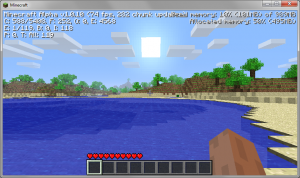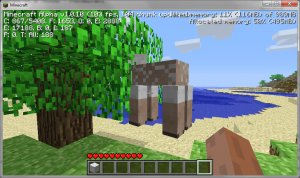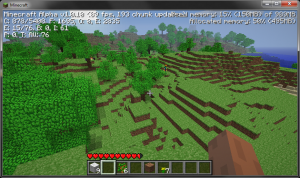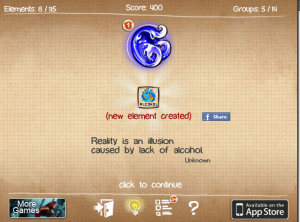The Adventures of a Noob is a recurring column in which I dive into a (potentially) complex game without reading the manual, FAQ, any help files, or playing a tutorial. I then catalog my first impressions and thought process as I attempt to figure out the game. This may end up being amusing, or it may end up being informative. Hopefully a little of both.
Note that in these types of articles, information in regular font represents my thought process/knowledge at time of first playing. Addendums in italics represent information I learned after the fact, inserted into the article to clarify which of my original thoughts were accurate and which were leading me astray.
Minecraft seems to be taking the Internet by storm lately, and after hearing about the basic premise, I felt as I had no choice but to invest my 10 Euros (approximately $13, and paypal seemed to do all the currency conversion for me). If you haven't heard of the game yet, here's the summary of what I knew before I jumped in:
- The game is made up of cubes (kind of voxels, really). All cubes are destructible/harvestable/buildable (ok, not quite all of them, but for the most part this statement was accurate).
- There's monsters and stuff
- There's crafting
- The "team" is one dude, who quit his job to make this indie game full time. The dude in question is Markus Persson, who lives in Sweden, though other folks have contributed to the project and are credited at the game's official site.
First thing I did in the game was go to configure options, which is generally my first action in any PC game--usually to set video options appropriately. This let me "cheat" a little bit in terms of my noob challenge, in that I saw the control configuration, at least for the keyboard.
Next I selected a save file (world) to play in, and the game generated a brand spanking new world for me. This game features randomly generated infinite worlds. Cool! Here's what I was greeted with as soon as I spawned in game:
 Alright, I see water in front of me, I appear to be on sand, and there's some trees on a hill in the distance. Looking around I don't see any monsters coming for me, so that's a bit of a relief (Monsters only spawn in the dark or at night). Let's press that I key to see what I've got in my inventory:
Alright, I see water in front of me, I appear to be on sand, and there's some trees on a hill in the distance. Looking around I don't see any monsters coming for me, so that's a bit of a relief (Monsters only spawn in the dark or at night). Let's press that I key to see what I've got in my inventory:
 Nothing. Hardcore. I expected to spawn with a little something-something. My eyes are drawn pretty instantly to the crafting area, which I look forward to messing with soon. First, I'll have to acquire ingredients, so time to wander around. As I do so, I notice that a little border surrounds a cube when I focus my crosshair on it. Clicking plays an animation, accompanied by a particle effect, but seems to accomplish nothing. Hmmm.
Nothing. Hardcore. I expected to spawn with a little something-something. My eyes are drawn pretty instantly to the crafting area, which I look forward to messing with soon. First, I'll have to acquire ingredients, so time to wander around. As I do so, I notice that a little border surrounds a cube when I focus my crosshair on it. Clicking plays an animation, accompanied by a particle effect, but seems to accomplish nothing. Hmmm.

As I wander, I encounter some sheep. I don't know if I need to eat food in the game, but maybe I do (I don't, but food heals you if you get hurt), so I resolve to kill the sheep. I walk up to it and click and...
 Cool, it got sheared rather than butchered! That comes as a surprise to me and provides me with my first item (a cube of wool, seen down at the bottom). I try to craft a shirt out of the wool, but crafting requires multiple ingredients apparently. I press the number 1 and discover that it's the control to switch to the first item on the bottom (this wasn't in the options screen). I can't figure out the control to switch back to my arm though, none of the other number keys do it.   After what was, in retrospect, an embarrassingly long period of fumbling around, I discover that the mousewheel cycles through those boxes.
Cool, it got sheared rather than butchered! That comes as a surprise to me and provides me with my first item (a cube of wool, seen down at the bottom). I try to craft a shirt out of the wool, but crafting requires multiple ingredients apparently. I press the number 1 and discover that it's the control to switch to the first item on the bottom (this wasn't in the options screen). I can't figure out the control to switch back to my arm though, none of the other number keys do it.   After what was, in retrospect, an embarrassingly long period of fumbling around, I discover that the mousewheel cycles through those boxes.
While wandering about, I pick a flower. I try crafting together the wool and the flower (don't ask me what I was trying to make), but clicking the arrow does nothing. I guess that's not a valid combo.
I found a pig, and tried to beat it into bacon. My punches seem to hurt it, but after several it's still alive, and I decide to let it go. Maybe I can't kill without a weapon?
Then I found a cow and killed him (it took a lot of punches), but he didn't drop anything. Weak (sometimes they drop leather).
I found a cool looking block and wanted to interact with it, but it hurt me. I think it's a cactus (yep).

Decided that if cows take a lot of hits, trees must be worse, so I whacked at it for some time. Nothing seems to happen. So I decide to try some digging. Still nothing... until I hold the left mouse button down. Eureka! Back to the tree... Success! " Hold the mouse button down" is a major scientific advancement for my people. Also, this is kind of cool:
 I later find out that eventually, the floating tree leftovers do indeed end up on the ground. It just takes awhile. Apparently though, floating Pandora-style islands are possible in the game, as well as gravity defying structures, at least, at the moment. The developer seems to push updates out very frequently (At least one update has been released between the events covered in this post and the date of posting).
I later find out that eventually, the floating tree leftovers do indeed end up on the ground. It just takes awhile. Apparently though, floating Pandora-style islands are possible in the game, as well as gravity defying structures, at least, at the moment. The developer seems to push updates out very frequently (At least one update has been released between the events covered in this post and the date of posting).
I decide that it's time to try some crafting again since I have a bunch of materials... and I hit another major scientific breakthrough: the result of crafting shows up automatically if you have a valid combo in the crafting area. Apparently, wood becomes lumber (the community seems to call "lumber" "planks").

Ok, so I've got lumber, I can use this to build myself a house. Somehow. After some experimentation, I find out how: right clicking. That is the "build" command("use" command, really) and places the lumber as a part of the environment. At this point, I start building the simplest of houses, quite frankly, even simpler than the block structures I build with my four year old nephew. I know the game has monsters, and having shelter will be a good thing eventually. I don't know if I need a bed to sleep and heal from the cactus (nope) or save the game (also nope, players can save any time with esc). So my goal at this point is really just a hollow cube for me to live in temporarily while I start grabbing some more materials to build a grander structure.

It gets pretty dark at night. I bet I could craft some sort of fire source, but I don't figure out how to do so (torches are craftable but I didn't have coal, a necessary component. I could also make fire with flint and steel, but I had neither). Back to building my house, I climb up top to put on my roof and I see some spiders in the distance. Not good. Why does it always have to be snakes spiders? They weren't there previously. I guess the game is Simon's Quest style, in that night is dangerous, and daytime is generally less so (yep, though underground can be deadly during the day as well).

I run out of wood to build my house, but with the spiders out there, I'm not sure I should go grab more at the moment. I think about going to another spot of trees, but I see something else that looks unfriendly (undead?). Maybe I'll just hang out on the roof until day time?
 That's ultimately what I decide to do, really hoping I don't have to clear these guys out come morning. I don't want to sound cowardly, but I barely killed a cow, and the cow wasn't fighting back. I don't have any weapons or armor, so I'm pretty sure fighting something would go poorly for me. Incidentally, my fear of the enemies was warranted, as they are pretty deadly. Particularly the green guys known as "creepers". They are essentially suicide bombers, which is extra awesome in this game, because they leave craters in the environment. Fortunately, my previous hypothesis was correct, and sunlight catches the guys on fire (though I later discover that the creepers and spiders don't burn up in the day time, so if any are nearby when the sunrises, they may still prove trouble):
That's ultimately what I decide to do, really hoping I don't have to clear these guys out come morning. I don't want to sound cowardly, but I barely killed a cow, and the cow wasn't fighting back. I don't have any weapons or armor, so I'm pretty sure fighting something would go poorly for me. Incidentally, my fear of the enemies was warranted, as they are pretty deadly. Particularly the green guys known as "creepers". They are essentially suicide bombers, which is extra awesome in this game, because they leave craters in the environment. Fortunately, my previous hypothesis was correct, and sunlight catches the guys on fire (though I later discover that the creepers and spiders don't burn up in the day time, so if any are nearby when the sunrises, they may still prove trouble):

I do a little bit more exploring and chopping and mining. I find some sort of dark gray stone, so far not craftable with anything I've got (it was, actually, but the crafting interface isn't just a bag, the position you place the ingredients matters). There is another dark gray stone that just takes ages to mine and gives me nothing. I try to avoid that (it actually is an awesome source of stone, but yields nothing if punched, only dropping resources if harvested with a pick axe).
After gathering some more wood, I end up with a respectable shack:

At this point I decide that I need to actually consult some of the documentation, as I must be missing something. I have a bunch of ingredients, butI can't figure out how to craft anything but the planks still. I've surmised from the inventory screen that I should be able to craft items and armor, but haven't managed it yet. I also know I must be missing something with the mining thing.  I have reached the limit of what exploring the game on my own is going to do for me (at least within a reasonable period of time -- the described took probably an hour of play time?). So I look stuff up. Discoveries of great import follow:
- Right click to split stacks of goods. This turns out to be fairly vital, because some of the crafting recipes require the same good in multiple slots.
- Positions of ingredients on the crafting interface matters.
- Many items can't be crafted unless you do so at a crafting table (which can be built out of four planks arranged as a square)
- Some items require a furnace to melt them down (cool!)
- Torches are about the single most important item ever, and require a stick (craftable from two vertically lined up planks) and coal to make.
- Close second might be the various harvesting implements (pick axe, axe, shovel).
For as complex as a game as Minecraft is, I was pleasantly surprised at the initial successes I had in figuring it out. In the long run though, the documentation is definitely a necessity (the menu offers a grayed out tutorial, but the game IS in alpha, so there you go).













